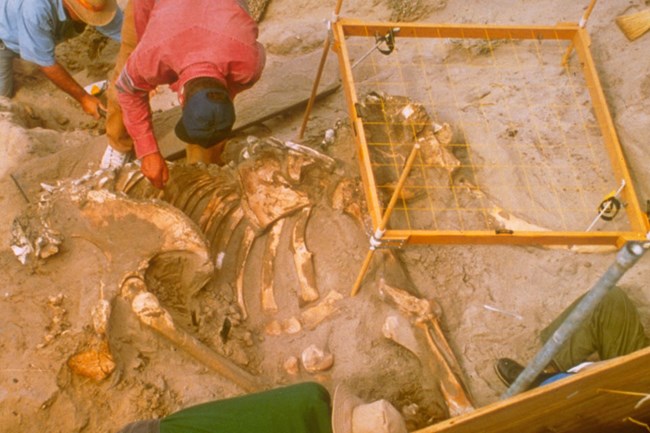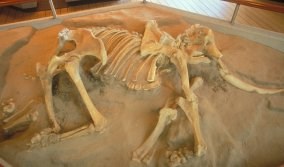
Paleontological Resource Inventory Mammoths have always fascinated people. From the creators of the earliest known cave painting and carvings to 20th century practitioners of modern art and even to today's tourists, humans have tried to grasp the essence of this magnificent creature – its enormous size, strength and beauty and its coexistence with and importance to humans. In 1994, paleontologists made the remarkable discovery of a pygmy mammoth on Santa Rosa Island, the most complete collection of its kind in the world. Found only on the California Channel Islands and nowhere else in the world, the pygmy mammoth was probably a small form of the Columbian mammoth found on the mainland. Pygmy mammoths varied from 4.5 to 7 feet high at the shoulders and may have weighed only about 2,000 pounds, compared to the 14-foot tall, 20,000 pound Columbian mammoth. In other respects, they were probably similar, with short fur, a typical mammoth body form, and a relatively large head. The first remains of "elephants" on Santa Rosa Island were reported in 1873. Additional excavations over the years have given a basic understanding of a population of mammoths on the islands which became smaller in body size through time and which perished as the Pleistocene ended. Paleontological excavations on Santa Rosa Island in 1927 and 1928 resulted in the retrieval of a significant collection of a new species described as Mammuthus exilis. Philip Orr of the Santa Barbara Museum of Natural History recovered additional materials during archeological and geological work on Santa Rosa Island during the 1940s and 1950s. Remains of mammoths are most common on Santa Rosa and The Journey to the Islands Approximately 20,000 years ago when sea level was about 300 feet lower than it is today, the four northern islands joined together to form an Ice Age “superisland” known as Santarosae. This island was only 6 miles from the mainland at its closest distance. As the ice sheets and glaciers melted and the sea level rose, only the highest parts of Santarosae remained as modern islands. But how did they reach the island? With their snorkel-like trunk and buoyant mass, elephants, living relatives of mammoths, are considered excellent distance swimmers, among the best of all land mammals, and skilled at crossing watergaps. Documented accounts demonstrate that Asian elephant swim to islands they cannot even see – some up to 23 miles away—guided by the odor of ripening fruit and vegetation. There is no reason that Pleistocene mammoths were not just as seaworthy, and just as good at swimming. 
Channel Islands National Park Evolving into a New Species Within less than 20,000 years, natural selection favored smaller-sized mammoths that stood less than 6.5 feet tall at the shoulder, less than half the height of their mainland ancestor. Thus, the small mammoths became a new species, the Channel Islands pygmy mammoth. The pygmy mammoth is an extinct member of an ancient and unique group of mammals collectively known as probiscideans. This name comes from the Greek word probiscis and refers to the large or extended noses. While the fossil history of this group spans over 55 million years and more than 160 different species, today’s elephants are the last survivors of this widespread group of animals. Extinction Special Islands Studying the pygmy mammoth reveals how important the Channel Islands are in illuminating the mysteries of evolution. The isolation of the islands have made them natural laboratories of evolutionary extravagance, as seen not only in the pygmy mammoth, but also in the extinct giant mouse, the diminutive island fox, the munchkin dudleya, and the giant, bright blue Island Jay. Isolated from their mainland relations and exposed to unique environmental conditions, the ancestors of these plants and animals, along with over 70 others, responded by becoming new species unique to the island – found nowhere else on earth.
Visit our keyboard shortcuts docs for details
Learn about the Channel Islands pygmy mammoth with specific information on the specimen found in 1994 on Santa Rosa Island
Visit our keyboard shortcuts docs for details
Details the excavation of the specimen found in 1994 on Santa Rosa Island.
Visit our keyboard shortcuts docs for details
Details the excavation of the specimen found in 1994 on Santa Rosa Island.
Visit our keyboard shortcuts docs for details
Details the excavation of the specimen found in 1994 on Santa Rosa Island.
Visit our keyboard shortcuts docs for details
Details the excavation of the specimen found in 1994 on Santa Rosa Island.
Visit our keyboard shortcuts docs for details
Learn how humans and mammoths interacted.
Visit our keyboard shortcuts docs for details
Learn about the role of islands in the evolution of species. |
Last updated: September 22, 2020
